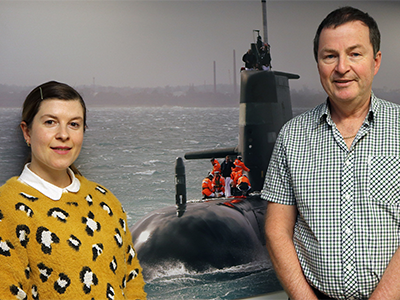Expanding and exploiting our understanding of the ocean

Defence scientists Dr Mike Greening and Holly McNabb believe the key to maritime supremacy is a deep knowledge of the ocean, and they are at the heart of DST’s support to RAN environmental forecasting.
“A lot of countries have very similar platforms and sonar systems. If you want to do better than your adversary, you have to use the equipment better,” says Mike. “Understanding the ocean environment and being able to predict its behaviour is one of the best ways for the RAN to get the most from its equipment.”
Ocean condition impacts sensors
It’s well known that ocean conditions have a significant impact on undersea warfare systems and sensors. Mike says ocean environmental models provide maps that are the ocean’s equivalent of weather patterns. They can identify, for example, areas where hull-mounted sonar performance is extremely poor, and where it is extremely good. While patterns change more slowly in the ocean than in the atmosphere, the changes are physically sharper. “Unless you have an ocean model that can generate these guides, you have no idea what’s out there,” he says. “All you know are the conditions immediately around your ship at one moment in time, and only then if you take the time to drop an expendable bathythermograph (XBT) to check.”
More accurate ocean models help the Royal Australian Navy make better decisions on where, when and how to employ sensors, and also with regard to mission or route planning. The team shares its knowledge and insights with RAN counterparts through mentoring provided to principal warfare officers and sonar operators, including sessions on undersea systems and how the atmosphere and ocean affects those systems. DST also uses a capability technology demonstrator to highlight the sorts of information that can be provided to maritime decision makers.
New understanding about ocean-atmosphere coupling
Holly joined the team six months ago, after working with sonar systems in various offshore environments including the North Sea and the Baltic as well as Scandinavia. She says the atmosphere plays a key role in the latest ocean modelling. “It’s a coupled system,” she explains. “The atmosphere absolutely affects what’s happening in the undersea environment. Dramatic climate events can also affect what’s happening underwater, so having the most accurate and comprehensive models ensures the warfighter is able to predict sensor performance.”
With a background in geophysical modelling, Holly has noted the push in environmental science towards a big picture, interdisciplinary approach to oceanographic modelling. “The hydrosphere, atmosphere, geosphere, biosphere and cryosphere are all coupled – when things change in one there’s a domino effect that impacts the others. Some of the existing models don’t reflect that, and don’t have variables that can change and adapt as fast as what the climate is now doing.”
The new interdisciplinary approach to modelling will mean working with teams from different specialities, fusing a wide range of information sources to sharpen the maritime warfighter’s toolkit. If they can accurately predict the ocean environment out to seven days, and successfully get those insights in front of navy operators, that will give the RAN a whole different level of capability.

